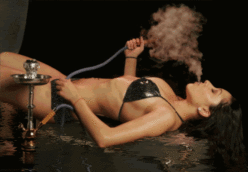The tobacco used in hookahs is different than that associated with cigarettes, or, indeed, any other form of smoking. It is, traditionally, a damp blend–called shisha, tobamel or maassel–of fresh tobacco leaves with molasses or honey and semi-dried fruit or fruit pulp. Some smokers would add pomegranate juice or perhaps rose oil to the water, which added flavor to the smoke. Later, hookah tobacco was also mixed with fruit extracts, and in the 1980s tobacconists began experimenting with various flavors, so that now a virtual smorgasbord of highly aromatic hookah tobacco is widely available.
While some hookah smokers still prefer a strong Turkish tobacco, many delight in the large assortment of flavored tobaccos, often called shisha. The dark, wet mixture comes in flavors ranging from apple, cherry, apricot, and watermelon, to rose, jasmine, vanilla, honey, and licorice, with more exotic blends beyond that, such as lemon-cola, cappuccino, apple-mint, and a list of custom blends that is nigh on infinite.
Prices for packaged tobacco range anywhere from $4 to $17 depending on quality, and a variety pack of flavors might cost about $30. The price in most lounges for a bowl of hookah tobacco ranges from $4 to $9 for slower burning leaf or custom blends.
Since hookah tobacco is very wet it must be smoked using a hookah charcoal. Rather than being lit directly, the tobacco is heated with a coal placed on tinfoil or wire mesh above or in the bowl holding the damp mixture. Each bowl of this wet tobacco lasts a long time, usually requiring several replenishments of the charcoal. In the past, among those rituals and traditions surrounding the lighting and smoking of the hookah, or narghile, were strict prohibitions against lighting the tobacco incorrectly–or even allowing a cigarette smoker to light their cigarette off of the hookah coal.
Hookah tobacco is generally only 30 percent tobacco and 70 percent fruit flavoring and molasses or honey. It contains .05 percent nicotine and most types contain no tar. Because the tobacco is heated, rather than actually burned, studies have shown that there are fewer carcinogens produced in hookah smoke than in other forms of smoking. However, concerns about the length of time smokers generally spend around a bowl of hookah tobacco do warrant consideration, and studies have shown that carbon dioxide intake is actually higher in hookah smoking. Though mellower and less carcinogenic, hookah tobacco is still tobacco and the health risks remain. Hookah tobacco should only be smoked by adults over 18 years of age, and then smoked in moderation.
